Non-regulatory options can be classified broadly as any measure taken to address issues related to the purchase and use of gift cards, that do not involve a change in regulatory frameworks that apply to their purchase and use. Such measures can enhance market outcomes by providing appropriate information to consumers who purchase and use gift cards and greater clarity as to how existing regulation applies to businesses that issue them.
Complaints received by ACL regulators appear to suggest that in some cases, terms and conditions are not well disclosed to the consumer.109 Both purchasers and gift card issuers share responsibility in ensuring that any important terms, conditions or administrative practices are understood by the receiver. Issuers are responsible for ensuring that information is available and effectively communicated. The purchaser is responsible for ensuring that they, and the receiver, have understood how the product works. While regulatory measures can work to standardise disclosure or simplify gift card products, non-regulatory responses can be used to promote the co-responsibility of gift card issuers and consumers.
While regulatory approaches can be used to the benefit of some consumers, they may also create difficulties when being implemented in practice. Adopting a range of non-regulatory measures can work to achieve beneficial outcomes for consumers without compromising the efficient operation of the Australian gift card market. This discussion is extended to include quasi-regulatory options—such as voluntary codes of conduct—which may provide more flexibility than alternative regulatory responses.
Consumer education and awareness
While electronic payment systems are not new to consumers, the popularity of gift cards presented in their more modern form has been a relatively new experience. Terms, conditions as well as administration practices that apply to some gift cards can vary substantially from other gift cards and from other forms of electronic payments.110 Accordingly, issuers have a responsibility to make terms and conditions clearly available and understandable to consumers. Similarly consumers must be made aware that they cannot rely on the assumption of a 'standard form' gift card.
Efficient markets rely on the availability of information so that individual actors can make informed decisions. In practice this includes consumers having access to a broad range of information on a variety of products so that purchase decisions reflect the preferences of the consumer. In a well-functioning gift card market, it would be expected that purchasers would seek out gift cards with favourable terms and conditions to the extent that these are valued by the receiver. However, as is clear from the submissions111, purchasers rarely compare gift card products in this manner. Given the complexity of gift card terms and conditions, as well as a commonly held belief that all gift cards are alike and can be treated like cash, consumers may not instinctively think to do so. Greater consumer awareness around the variation of terms, conditions as well as administration practices may be beneficial.
Increasing consumer awareness
There are a range of activities that ACL regulators and other consumer advocates have engaged in to improve outcomes for consumers of gift card products.112 This work has been useful in highlighting key differences in gift card terms and conditions, but has also provided consumers with the tools to compare and select gift cards that suit their individual needs. Recent media reports as well as the CCAAC review have also contributed to this process. However, there may be some scope for further work in this regard.
Gift card purchases increase at specific times of the year. For example, gift card sales peak during the Christmas period and are popular at other times of the year such as Mother's and Father's Day. As suggested in some submissions113, consideration could be given to when consumer education activities could be targeted. ACL regulators could, for example, issue a joint media release highlighting that care needs to be taken when using gift card products before key gift giving periods.
While it may be possible for ACL regulators to provide information to consumers on their websites, this information is more likely to be accessed after a consumer has experienced a problem in using a gift card. Such a consumer is likely to be interested in information relating to their rights under the law. Messages that support consumers are likely to be more useful where they are expressed generically so that they can assist consumers when purchasing any kind of consumer good or service.
Existing consumer education activities
A number of ACL regulators have placed information on their websites to assist consumers when purchasing and using gift cards.114 This information assists consumers in understanding their rights under the law and also provides some practical guidance where a consumer believes that a gift card issuer has not acted in accordance with the law.
Some ACL regulators also provide tips to consumers when purchasing gift cards.115 This information can assist consumers in being aware that terms and conditions apply and that there are some things that consumers should do to ensure that they get the most out of their gift card products.
The MoneySmart website
The MoneySmart website, which is administered and operated by ASIC, provides consumers with practical guidance to assist gift card holders. This information includes that gift cards should be kept safely, that gift card holders should check the expiry date, and that remaining balances will not necessarily provided back in cash.
Figure 3: Gift card guidance on the MoneySmart website116
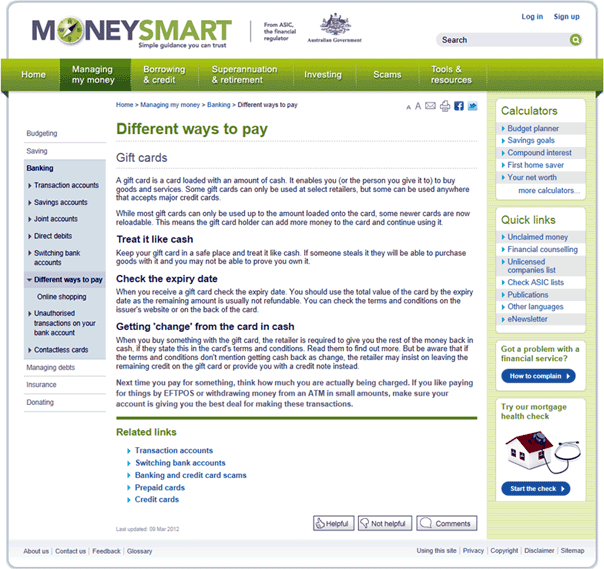
The MoneySmart website also provides specific guidance to gift card holders who are experiencing losses due to a business going into administration. This information can be specifically targeted to individual businesses and can provide consumers with suggestions such as applying for a 'chargeback' through their bank where it has been purchased with a credit card.
The MoneySmart website also refers to a factsheet on 'insolvency for consumers' that has been prepared by ASIC. This factsheet outlines how insolvencies may affect consumers, including where they may be considered as an unsecured creditor, such as where a gift card has not been used. This information outlines where consumers can go to for help, as well as providing an outline of the rights of unsecured creditors under the Corporations Act. It is common for ACL regulators to refer consumers to the MoneySmart website where complaints are made in relation to a business going into administration.
Figure 4: Insolvency guidance on the MoneySmart website117
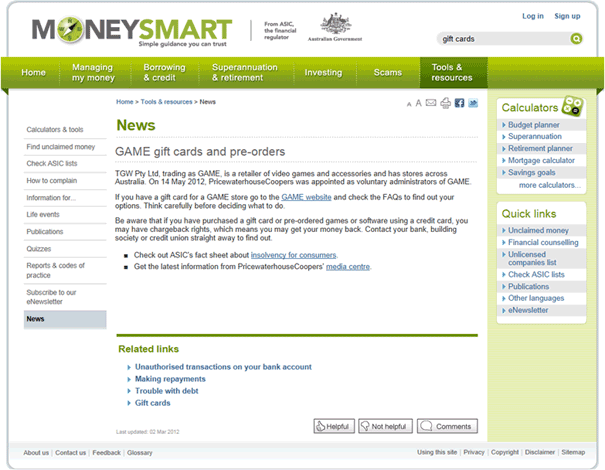
Consumer phone applications
ACL regulators have also introduced shopping rights phone applications to support consumers when purchasing goods or services. Shopping rights phone applications operate on smart phones and can be downloaded for free. They are particularly useful for consumers as they provide instant and authoritative
guidance to consumers whenever they may need it.
Shopping rights phone applications provide targeted information that is useful to consumers when consumers may be requesting a refund or exchange. This includes information on consumer rights when seeking to return a good. The applications also contain information relating to gift cards. For example, the MyShopRights phone application notes that:
'A store does not have to honour a gift voucher or gift card after the expiry date, unless they told you that they would.' and
'When you make a purchase using a gift voucher, the store is required to give you cash for the leftover value if they told you they would, or if it was stated in the terms of the voucher.'
Shopping rights phone applications also allow gift card holders to place a reminder for before a gift card expires. This feature assists consumers in ensuring that any gift cards they hold are redeemed before the date of expiry. This feature can also work for any other goods or services where an expiry date may affect some part of the product's use.
Overall, phone applications provide an innovative way for ACL regulators to inform consumers on their rights, but also to provide additional services—including reminders— that may be of assistance to gift card holders.
Findings
ACL regulators should continue to explore how consumers can be supported when purchasing gift card products. ACL regulators have already engaged in activities that could benefit consumers who purchase and receive gift card products. CCAAC notes the work of ASIC in educating consumers about insolvency risks as well as consumer rights in the event of insolvency.
ACL regulators could consider issuing a joint media release at key gift giving periods to raise consumer awareness. The effectiveness of this measure could be evaluated after a two year period where the need for any future education activities could be reassessed.
Figure 5: Phone application screenshots
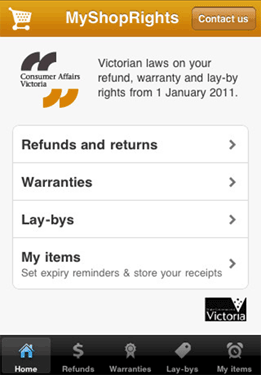

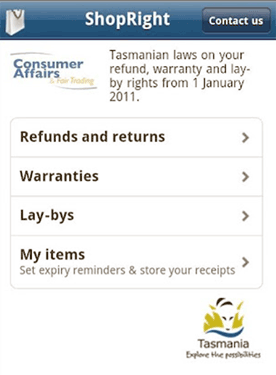
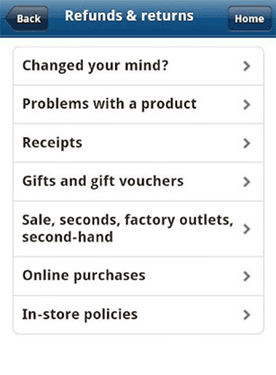
Business education and compliance promotion
It appears that most issuers act consistently with existing regulation, and the experiences of individual consumers may reflect isolated instances of non-compliance (rather than a systemic failure). Business education and compliance activities can benefit consumers where they achieve broader compliance with existing laws. While these may be useful, they should be considered in accordance with the broader compliance and enforcement priorities of ACL regulators.
Existing business education and compliance activities
To support the implementation of the ACL on 1 January 2011, ACL regulators have worked together to produce general guidance on the ACL. This guidance assists businesses in ensuring that their trade practices are compliant with the ACL. To assist a broader range of businesses, this guidance explains the generic principles of the ACL. ACL regulators have produced a series of 'ACL Guides' on:
- avoiding unfair business practices;
- consumer guarantees;
- product safety;
- sales practices;
- unfair contract terms; and
- compliance and enforcement.
These guides have been developed by ACL regulators and are available on the
The Queensland Office of Fair Trading has also encouraged gift card issuers to apply a minimum set of terms, conditions and administration practices. This information is available on
the Queensland Office of Fair Trading website.
Findings
CCAAC notes the work of ACL regulators in promoting broader compliance with the ACL. Gift card issuers could be supported by the existing guidance on how the generic consumer protection principles of the ASIC Act and the ACL apply to businesses. Any work to promote compliance should be targeted at businesses that may be less clear about their legal obligations. ACL regulators could explore whether there is broad industry compliance with the existing law in accordance with the relevant compliance and enforcement policies that apply.
Assessing and evaluating consumer and business education campaign proposals
While education activities may offer benefits to consumers, there are likely to be costs associated with the implementation of consumer and business education campaigns. Any cost associated with such campaigns should be consistent with the benefits they provide.
Non-regulatory approaches may provide additional positive benefits to consumers participating in a wider range of markets. In this regard, non-regulatory approaches have the potential to provide broad and far reaching benefits beyond their specific application to consumers of gift card products and their merit can be considered in this context.
Some activities are likely to be capable of being supported by existing infrastructure and can be implemented at relatively low cost. These should be pursued as a priority while more resource intensive proposals should be subject to an analysis of all associated costs and benefits. Finally, education activities should be targeted where they can offer the most benefit to consumers.
Findings
Education activities should be assessed in accordance with appropriate enforcement and compliance priorities. Any costs associated with these activities should be appropriate to the expected consumer benefits. CCAAC notes that ACL regulators have developed a number of resources to support the implementation of the ACL. CCAAC finds that any activities to increase consumer awareness in relation to gift cards should be integrated into current education activities where possible.
Quasi-regulation
According to the OBPR, quasi-regulation includes a wide range of rules or arrangements where governments influence businesses to comply, but which do not form part of explicit government regulation.118 This could include voluntary industry codes of practice developed with government involvement, guidance notes, industry-government agreements and accreditation schemes.
Quasi-regulatory measures, as they could be applied to gift cards, may offer a range of benefits over more traditional regulatory approaches as they are more responsive to changes in technology and market conditions. They can be used to provide the industry with ownership over any new rules or guidelines that may apply and can offer flexibility where altering existing legal infrastructure is unsuitable. Australia's consumer protection framework is generic in nature, so including specific provisions relating to the purchase and use of gift cards may not be appropriate. Quasi-regulatory measures could be used to address market failures owing to any unique characteristics that create difficulties for the participants of a market.
A voluntary industry code
A voluntary industry code could assist in addressing a range of issues relating to gift card products. It could be based on best practice principles that support consumers where gift card terms and conditions are applied. A voluntary indu
stry code, could offer a range of benefits including greater flexibility, lower compliance costs and greater responsiveness to business conditions.
The Australian Government has issued guidance on developing voluntary industry codes.119 The guidance expresses a preference for voluntary codes of conduct—which can be effectively developed, implemented and enforced by the participants in an industry—than more heavy handed regulatory approaches. The guidance further notes that if an industry has not sought to self-regulate to resolve an identified problem, any subsequent attempts to do so should be considered before a more heavy-handed regulatory response is considered.
Best practice promotion
It is noted that some segments of the retail industry have expressed a willingness to explore self-regulatory options that could ensure that consumers are presented with reasonable and fair terms and conditions when purchasing and using gift cards. ANRA has proposed that a voluntary code of practice, acting as a minimum standard, be developed to increase consumer confidence in the gift card programs operated by signatories to the code. Other segments of the retail industry have commented that a voluntary code of conduct would impose unnecessary administrative burdens given that most retailers already comply with what might be considered to be best practice.120
Alternatively, best practice promotion could be achieved through an accreditation or rating scheme which would allow gift card issuers to highlight that above best practice terms and conditions apply. This approach would be different to a voluntary code of conduct as the focus would not be on enforcing rules, but rather promoting the beneficial features of an issuer's gift card products. This could improve consumer awareness of gift card terms and conditions, and encourage gift card issuers to respond to market incentives through product differentiation.
A discussion on minimum best practice standards which could be used as a basis for industry developed standards can be found in Box 2.
Box 2: Minimum best practice standards
In recognition of the benefits gained through issuing gift card products, industry could consider what it could do to further support consumers who purchase and receive gift card products. Industry best practice promotion requires some consideration as to what constitutes industry best practice. It is important that industry develops these standards so that they have ownership over them and can be widely embraced by market participants. More generally, the Australian Youth Forum's submission provided some practical suggestions as to how gift card issuers could assist consumers. This included that:
- gift card issuers have websites where gift card details can be checked;
- larger businesses have longer expiry dates;
- reminder emails be sent where an expiry date is approaching;
- gift cards come with a plain English summary of the terms and conditions; and
- lost or stolen gift cards can be cancelled and replaced.
While many gift card issuers have already implemented some of these suggestions, they could for example form part of any industry efforts to promote best practice terms and conditions to the broader market.
CCAAC considers that industry best practice should, at a minimum, include that:
- expiry dates should be more than 12 months unless a shorter expiry date is reasonably necessary to protect the legitimate interests of the gift card issuer;
- purchasers should be specifically alerted to the expiry date at the point of sale where it is for a period of less than 12 months;
- grace periods should be offered to the consumer, particularly where they have remembered to redeem a gift card after the anniversary of an event such as a birthday or Christmas;
- expiry dates and other important terms should be prominently listed on the gift card itself (in consideration that card holders or wallets supplied with the gift card are often discarded by the purchaser or recipient);
- lost, stolen, or damaged gift cards should be replaced where a consumer is able to provide a proof of purchase and it is possible to reissue a gift card;
- fees should not be applied unless they are upfront fees paid by the gift card purchaser or special fees applied when replacing lost or misplaced gift cards; and
- customer service and complaints handling procedures should be developed and complied with at the store level.
The ePayments Code
The ePayments Code (the Code) was published on 20 September 2011. This voluntary code of practice regulates electronic payments, including online payments, internet and mobile banking, some non-cash facilities like gift cards, as well as BPAY, ATM, EFTPOS and credit card transactions. It provides a consumer protection regime for electronic payments. The code establishes a set of reasonable and fair terms, conditions, and administration procedures that support the existing consumer protection framework.
Those who subscribe to the code must begin complying with the new code by 20 March 2013. ASIC has indicated that all current members of the EFT Code—including banks, credit unions and building societies that provide retail banking services—are expected to resubscribe. Other providers of new payment services who may not have subscribed to the previous code are expected to sign up.
The Code offers a consumer protection regime that has broad applicability to electronic payment products and services that may not currently be subject to any industry codes or regulations. The code has the potential to regulate the application and disclosure of expiry dates on gift cards. The most important requirements for gift card issuers are that subscribers agree to:
- not apply an expiry date of less than 12 months from activation of the card;
- provide disclosure of the expiry date prominently on the device itself; and
- give the consumer a method of checking the expiry date.121
ASIC has noted that it has some concerns that newer operators in the electronic payment market are now offering increasingly complex and high value products and are neither subscribing to, nor compliant with the Code. This leaves consumers without the protection of the requirements set out in the code.
ASIC suggests that a minimum expiry period that is consistent across all types of gift cards would help address a number of current issues with gift cards, but notes that currently this would require the subscription of all gift card issuers to the code.
Businesses that issue gift card products are able to subscribe to the Code. Products like gift cards would not be subject to the full requirements of the Code.122 There is some scope to achieve consistency in terms, conditions and disclosure practices across different payment platforms. Legal commentary of the review also highlighted the benefits of streamlined regulation.123 The Code provides for broad coverage across a range of electronic payment forms. Greater subscription to the Code, amongst gift card issuers, would be a positive step.
There are a number of benefits for gift card issuers subscribing to the Code. Subscription to the Code can allow consumers to be confident about purchasing and using gift card products issued by Code subscribers. Where Code subscription is promoted to the consumer, gift card issuers are able to signal that they are offering a high quality product. The benefits of subscribing to the code are particularly pronounced where a gift card issuer may already operate a gift card program that is complia
nt with the Code.
On 11 May 2012, CCAAC held meetings with the retail peak bodies and gift card issuers. At these meetings, CCAAC expressed the view that some of the consumer concerns relating to the purchase and use of gift cards could be addressed through membership of the Code.
Findings
Industry groups are encouraged to develop a set of best practice principles that can be promoted to their members. While industry participation in the ePayments code is encouraged, CCAAC does not consider that a voluntary code of conduct is likely to resolve some of the concerns raised by consumers. To avoid further calls for a regulatory response, industry may wish to explore whether there is any scope to promote best practice terms and conditions. This could be achieved through an accreditation or rating scheme based on a minimum set of requirements.
CCAAC proposes that industry be allowed time to develop and apply best practice standards with regard to gift cards. After three years, industry efforts to address current consumer concerns could be revisited.
CCAAC encourages ACL regulators to monitor any developments, or new evidence of systemic consumer detriment, that may arise. Should any new concerns arise, CCAAC considers that effective self-regulation should be considered as a first best option.
Developing a strategic non-regulatory response
All components within a non-regulatory response should work together to achieve the objectives identified by CCAAC. A strategic non-regulatory response could work to improve business' understanding and compliance with existing obligations under the ACL, encourage gift card issuers to apply best practice terms and conditions as well as supporting businesses that exceed best practice. Consumer Affairs Australia and New Zealand (CAANZ) and its advisory committees are best placed to implement such a strategic response.
| Target outcomes | |||
|---|---|---|---|
| Compliance with existing obligations under the ACL and the ASIC Act. | Encouraging best practices for disclosing terms and conditions. | Supporting businesses that exceed best practices around terms and conditions | |
| Non-regulatory policy instruments | Increasing business awareness of existing obligations under the ACL and the ASIC Act.
|
Industry best practice promotion through industry support for best practice terms and conditions.
|
Enhancing market incentives through increased consumer awareness and signalling mechanisms.
|
CAANZ and its advisory committees are encouraged to develop a coordinated strategic non-regulatory response, based on the findings of the CCAAC review into gift cards in the Australian market. This response would support gift card holders and assist consumers in an evolving marketplace. Specifically, the Education and Information Advisory Committee (EIAC), the Policy and Research Advisory Committee (PRAC) and the Compliance and Dispute Resolution Advisory Committee (CDRAC) should work together to ensure that activities are coordinated.
109 See Appendix 6.
110 A variety of the terms applied to gift cards is available in Appendix 8.
111 Queensland Consumers' Association, p 3. Blackhawk Network, p 9.
112 For example, CHOICE has highlighted some of the key differences in terms and conditions that apply to gift cards.
113 For example, Queensland Consumers Association, p 3.
114 For example, see the
Consumer Affairs, Victoria website
115 For example, see the Consumer and Business Services, Government of South Australia website.
116 This webpage is available on the
MoneySmart website (accessed on 25 May 2012).
117 This webpage is available on the MoneySmart website (accessed on 25 May 2012).
118 2010 Best Practice Handbook, Office of Best Practice Regulation, Australian Government, p 34.
119 Policy Guidelines on Prescribing Industry Codes, Australian Government, May 2011, p.2. Available on the
Treasury website (Accessed 29 May 2012)
120 CCAAC meetings with industry groups on 11 May 2012
121 ePayments code. Available on the
ASIC website (accessed 22 May 2011).
122 Products that do not store more than $500 of value are deemed 'low value facilities' under the Code.
123 Anastas, M. 'In the Spotlight: Gift Cards Under Review', Australian Banking and Finance Law Bulletin, March 2012, pp 162-164.